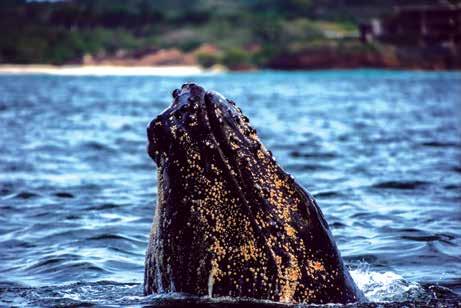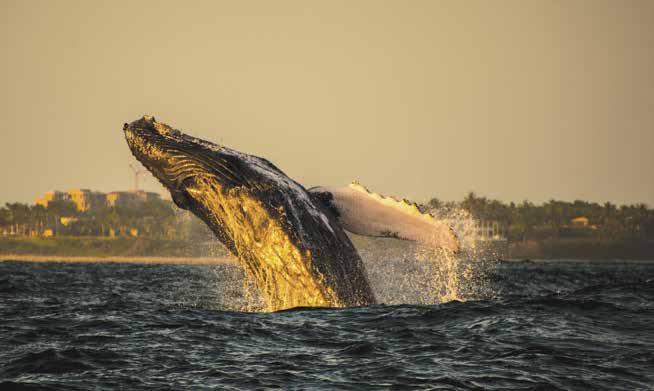
4 minute read
FROM ALASKA TO MEXICO: The Humpback Whale’s Journey

BY SDMN
Advertisement
Emiliano Arroyo began studying marine fauna twelve years ago. He began as a student at the Faculty of Sciences of the Universidad Autónoma de Mexico (UNAM). While he was there, he quickly became involved in one of the most interesting research groups in Latin America: the Marine Mammalogy Group of the UNAM. Since its foundation in 1981 by the Chilean biologist Anelio Aguayo, and now, with the coordination of Luis Medrano González and María de Jesús Vázquez, this group has been investigating marine mammals. They capture data, take photographs, record sounds to learn more about these animals and to raise awareness of the importance of their preservation. One of the species they study is the humpback whale. Every year, these whales travel from the cold waters of the north, especially here in Alaska, to Mexico. There, they spend a few months and return. This journey is fascinating, so we talked to Emiliano to learn more about this process and the challenges facing these cetaceans.
“Humpback whales migrate from high latitudes, in this case from Alaska, Cana da, the United States, to tropical latitudes. The destinations to which they normally migrate can be the Mexican Pacific, such as the Baja California peninsula and the Revillagigedo Archipelago. However, from Alaska, they can also go to Hawaii.” The reason behind the trip seems simple: humpback whales come to Mexican wa ters because they are warmer compared to the frigid waters of the northern hemi sphere and, once here, they reproduce. However, this trip is about much more than mating. Emiliano commented: “Re production refers to finding a partner, mating, pregnancy, giving birth and parental care.” Males are looking for a partner and they do so by fighting or singing. In fact, male humpback whales are the only cetaceans that compose songs. Although every cetacean can make sounds, humpback whales demonstrate knowledge of tones and phrases. On the other hand, females have a different and more complicated task. Emiliano commented that they “come to Mexican waters to mate or to have their offspring. If they have their offspring, they have them in tropical waters for two or three months. There, they breastfeed them, teach them how to swim, adapt for a while, they teach them how to be whales and prepare to travel with them during migration.”
The journey is long, according to Emiliano, it is approximately 10,000 km. Sometimes whales stop to feed, but doing so affects the time they can spend in breeding areas. In addition, stopping exposes them to dangers, such as their predators, orcas. However, sometimes whales travel in groups to protect them- selves and help each other. Emiliano compared them to some migratory birds: “Some in front, others behind, breaking currents and taking care of each other from their surroundings.” Although, in addition to natural challenges, whales must face difficulties caused by humans: chemical, physical and even acoustic pollution. Humpback whales can be injured by fishing lines and are even run over by boats. In addition, their ears are very sensitive. “Whales hear the same way we see,” Emiliano said. Therefore, oil drilling, pyrotechnics on cruise ships and all the sounds we cause in the water have a negative impact on their well-being.
Humpback whales are not immune to the impact of climate change either. Although in the short term, the change in temperatures would benefit them by expanding their feeding areas, in the long term, it will bring negative consequences by changing the life cycle of their food, krill and other small fish, which will reduce their food supply. In addition, climate change can also lead them to alter their migratory pattern. Emiliano told us phenomenon in 2016 was a sign of this: “There were almost no whales on the coasts, they were in the open sea and that was because of the warming of the water.” tonos y de frases. Por su parte, las hembras tienen una tarea distinta y más complicada. Emiliano comentó que ellas “vienen a aguas mexicanas a aparearse o a tener sus crías. Si tienen a sus crías, las tienen en aguas tropicales por dos o tres meses. Ahí las tienen para enseñarlas a nadar, para amamantarlas, para que se adapten un tiempo, para enseñarlas a ser ballenas y para prepararlas para acompañarlas a la migración”.
It is important to protect these animals and we can all help. Emiliano commented that, at the political level, it is important to continue respecting the rules, laws and international treaties around the conservation of whales but it is also imperative that we continue to protect their spaces and their biological cycle and that we continue to support research on these animals and share information so that more people can know how fantastic they are.
La travesía es larga, de acuerdo con Emiliano, es de aproximadamente 10,000 km. En algunas ocasiones hacen paradas para alimentarse, pero hacerlo repercute el tiempo que puedan pasar en zonas de reproducción. Además, las expone a peligros, como sus depredadores, las orcas. Sin embargo, a veces las ballenas viajan en grupo para protegerse y ayudarse. Emiliano las comparó con algunas aves migratorias: “Unas delante, otras detrás, van rompiendo corrientes y cuidándose de los alrededores”. Aunque, además de desafíos naturales, las ballenas tienen que encarar dificultades causadas por los humanos: contaminación química, física e incluso acústica. Las ballenas jorobadas pueden sufrir heridas por líneas de pesca e incluso morir atropelladas por embarcaciones. Además, sus oídos son muy sensibles. “Las ballenas oyen tan bien como nosotros vemos” comentó Emiliano. Por ende, las perforaciones petroleras, la pirotecnia en cruceros y todos los sonidos que causamos en el agua tienen un impacto negativo.
Las ballenas jorobadas tampoco son ajenas a los efectos del cambio climático. Aunque, a corto plazo, el incremento de las temperaturas va a expandir sus zonas de alimentación, a largo plazo, este fenómeno traerá efectos perjudiciales al alterar el ciclo de vida de sus alimentos, el krill y otros peces pequeños, reduciendo el suministro de comida. Además, a pesar de que no es frecuente, el cambio climático puede obligarlas a modificar su ruta migratoria. Emiliano nos comentó que el fenómeno de El Niño en 2016 fue muestra de esto: “No había casi ballenas en las costas, estaban en el mar abierto y eso fue por el calentamiento del agua”.
Es importante proteger estos animales y todos podemos ayudar. Emiliano comentó que, a nivel político, es importante seguir respetando las reglas, leyes y tratados internacionales alrededor de la conservación de ballenas, pero también es imperativo que sigamos protegiendo sus espacios y su ciclo biológico y que sigamos apoyando las investigaciones sobre estos animales y compartiendo información para que más personas puedan saber lo fantásticos que son.






